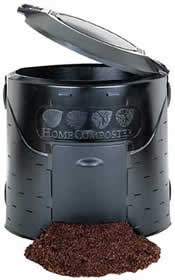Composting at home is easier than you think and is a great way to cut the amount you throw away. You also improve your soil when you use finished compost.
Composting happens when microbes break down food scraps, grass clippings and leaves into a soil-like material called compost. Compost is rich in plant food, holds more water than regular soil, and lessens the need for fertilizers and weed killers.
Backyard composting
Get a bin
Compost bins help keep the material together, keep critters out and may be required in your city.
 Purchase a bin
Purchase a bin
Build your own
Here are helpful instructions on how to build a simple compost bin.
Choose a place for your bin that is:
- Convenient for you to add materials in all seasons
- Out of direct sunlight to avoid overheating
- Away from roof drainage to prevent flooding your container.
The right recipe
Microbes need four key ingredients: “browns”, “greens,” water and oxygen. Most water comes from food scraps, so you shouldn’t have to add any extra moisture. The pile should feel damp when you touch it, but not soggy. If the pile is too soggy, it will smell. Add air by turning your pile with a garden fork. Turning isn’t a requirement of compost piles but it speeds up the process.
Browns & greens
For every one kitchen pail of food added to your compost bin, add three big handfuls of dried leaves or straw. The best compost will come from a 3:1 ratio of browns to greens, but you don’t have to get scientific about it.
|
Browns (sources of carbon for the compost) | Greens (sources of nitrogen) |
- Dried leaves, garden debris, plant trimmings
- Straw and hay
- Wood (in small amounts): saw dust, wood chips, sticks
- Pine needles (in small amounts) and pine cones
- Paper egg cartons (remove labels)
- Tissues, paper towels and napkins
| - Food: fruit and vegetable scraps, rinds, peels, egg shells
- Coffee grounds and filters
- Tea bags
- Fresh grass clippings (but it’s better to leave this on your yard)
|
DO NOT add these items because they can attract rodents or spread bacteria and plant diseases.
- Meat, bones, fish and dairy
- Fats: cooking oil and grease
- Feces: Pet and human
- Diseased plants & weeds that have gone to seed
- Ash from charcoal or coal
Using your compost
You do not have to use your compost. Your pile should shrink over time as compost slowly seeps into the ground.
Well maintained compost piles will be ready for use in two to four months, but it may take up to a year under other conditions. You’ll know your compost is ready when the pile is dark, crumbly and smells like fresh dirt. You can still compost in the winter, but the process may slow down.
Use your compost for many things:
- Mix compost in with your soil to improve quality.
- Use it to fill in low spots in your yard.
- Use it as mulch for landscaping and garden plants.
- Mix compost in the soil for potted plants. Do not add more than 50 percent compost to pots.
Troubleshooting
For help with composting issues:
- Visit
Ask an Expert from University of Minnesota Extension Office
- Call Dakota County at 952-891-7557
Indoor composting
Vermicomposting uses worms to break down the food scraps to create a vermicast, a product that can be used as a fertilizer. The worms are placed in a bin, which doesn't need much space.
Purchase a bin
- Few local garden or home improvement stores carry vermicompost bins
-
Gardener’s Supply—Worm Factory
Put your bin in a location with moderate temperatures (55-70 degrees Fahrenheit), like under the sink, cupboard or in a closet.
Get worms
The best type of worms are red wigglers (Eisenia foetida). One pound of red wigglers, or about a handful, is enough you started.
Ask your local garden center if they sell red wigglers or purchase them online:
Feed your worms
Start with a bedding at the bottom of your bin. Newspaper, cut into strips, or leaves are great materials. Over time, you will need to add additional bedding.
Add materials a few times a week, depending on how quickly the worms eat it. If the material is not eaten within a day or two, feed them a little less. Cover up fresh materials with newsletter or other bedding.
|
Add |
Keep out |
- Fruit
- Grains
- Vegetables
- Coffee grounds
- Egg shells
| - Meat
- Bones
- Onions
- Dairy
- Fats: cooking oil and grease
- Feces: Pet and human
- Greasy or fried foods
|
When kept up, vermicomposting shouldn’t smell or attract fruit flies.
Vermicast can be mixed directly into garden and indoor plant soil.
Dakota County lists any products for informational purposes only and does not endorse any product.
Learn More
Minnesota Pollution Control Agency printable factsheets
 How to Compost Your Organic Waste
How to Compost Your Organic Waste
Vermicomposting
 Composting with a Worm Bin — Oregon Metro
Composting with a Worm Bin — Oregon Metro